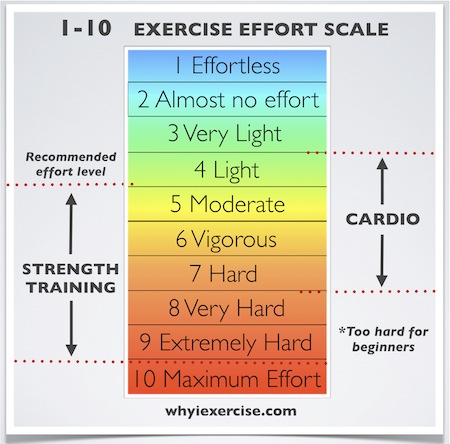1-10 Exercise Effort Scale
date: 2012-12-07  time: 14:00:00
time: 14:00:00
 time: 14:00:00
time: 14:00:00 Which is better for your workout, moderate or maximum effort?
How important is your level of effort? If you are trying too hard, it can be too much strain on your body. On the other hand, if you're not working at all, you won't get enough health benefits from the activity. The exercise effort scale and instructions below will help you find the optimal effort level for your workouts, based on your fitness level.

How to use the scale
Pay attention to how you feel during the workout. How fatigued are your muscles? How heavy is your breathing?
STRENGTH TRAINING
Give your effort a 1-10 rating for each exercise in your workout. When you finish an exercise, let your breathing return to normal before starting the next exercise. This will give you enough energy to continue. See the effort level descriptions.
If your effort is 5/10
You can feel your muscles working, but you finished the exercise with plenty of energy left. You could have done many more repetitions of the exercise. This is a good warm up effort level.
7/10
By the end of the exercise, you can feel your muscles fatiguing somewhat. Your breathing has also picked up, but you finished the exercise well before reaching your maximum effort. This is a safe strength training effort level for beginners who have no known joint or muscular problems.
8/10
By the end of the exercise, your muscles are fatiguing significantly, but you could have done 1-2 more reps of the exercise if you used a maximum effort. If you are new to exercise, workout consistently for several weeks before exercising at this effort level.
9/10
You have to focus intensively to complete the exercise with correct form. When you finish, you are not able to do any more reps of the exercise.
10/10
During a maximum effort exercise, your movement will be much slower on the last repetition. Your muscles may 'fail' (stop working) and keep you from finishing the move.
To exercise at 9/10 or higher, it is best to have experience with exercise and also be free of joint and muscle problems. *Get clearance from your doctor before trying a high intensity workout.* Maximum effort workouts can give you great results, but they are also have the highest risk of injury. Do a max effort workout with a partner who is ready to assist you if needed. Also, to avoid overuse injury, no more than 1 max effort strength workout per week is needed, though you might have separate workouts for different muscle groups.
CARDIO EXERCISE
Give your effort a 1-10 rating about every 5 minutes of the activity.
If your effort is 3/10 or less
You aren’t sweating, you did not feel your heart rate pick up, and you could sing during this activity. You need to work harder (at least 4/10) to get a health benefit from the activity.
5/10
You can talk, but you couldn’t sing while you are exercising. You may have broken a sweat.
6/10
Your breathing and pulse have noticeably picked up. The workout is not as casual--you have to concentrate more on the activity to maintain this vigorous effort level. If you are new to exercise, workout consistently for several weeks before exercising at this effort level.
7-8/10
You are breathing heavily and you can’t say more than a few words without taking a breath.
9-10/10
You are gasping for air by the end of the exercise, and you need several minutes rest before you could start again.
For cardio efforts of 8/10 or higher, it is best to have some experience with exercise and also be free of joint and muscle problems. *Get clearance from your doctor first.*







